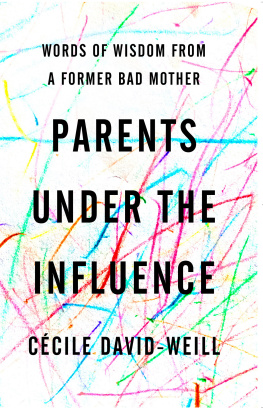SQUEEZING BIRTH INTO WORKING LIFE
Squeezing Birth into Working Life
Household panel data analyses comparing Germany,
Great Britain, Sweden and The Netherlands
CCILE WETZELS
University of Amsterdam
and TNO-Institute of Strategy, Technology and Policy,
Delft, The Netherlands
First published 2001 by Ashgate Publishing
Reissued 2019 by Routledge
2 Park Square, Milton Park, Abingdon, Oxon, OX14 4RN
52 Vanderbilt Avenue, New York, NY 10017
Routledge is an imprint of the Taylor & Francis Group, an informa business
Ccile Wetzels 2001
All rights reserved. No part of this book may be reprinted or reproduced or utilised in any form or by any electronic, mechanical, or other means, now known or hereafter invented, including photocopying and recording, or in any information storage or retrieval system, without permission in writing from the publishers.
Notice:
Product or corporate names may be trademarks or registered trademarks, and are used only for identification and explanation without intent to infringe.
Publishers Note
The publisher has gone to great lengths to ensure the quality of this reprint but points out that some imperfections in the original copies may be apparent.
Disclaimer
The publisher has made every effort to trace copyright holders and welcomes correspondence from those they have been unable to contact.
A Library of Congress record exists under LC control number:
ISBN 13: 978-1-138-63491-6 (hbk)
ISBN 13: 978-1-315-20477-2 (ebk)
Contents
This book is a slightly revised version of my doctoral thesis defended at the University of Amsterdam on January 21, 1999. Siv Gustafsson attracted me to the research on fertility, female labour supply and public policies. Having studied a completely different field, strategies of organisation at the economics department of Tilburg University, the spirit of the researchers working on Population and Gender Economics at the University of Amsterdam gave an interesting and stimulating encouragement to survey the field.
Participation in the European womens labour force network in 1995 at once revealed the structure of what the thesis should capture. At that time I made the following choices. First I chose to analyse womens labour force behaviour in a short term perspective and detailed, by making use of panel data on womens own human capital and monthly labour market behaviour and their spouses human capital and labour market behaviour. Secondly I chose to analyse womens birth labour market behaviour and timing of giving birth, by birth order. Thirdly I chose a country comparative perspective to reveal effects of different public policy packages in addition to effects explained by human capital theory.
The research required comparable household panel data sets between countries. The course on Using equivalent household data files at the Center for Policy Research, Maxwell School of Citizenship and Public Affairs, at Syracuse University New York sponsored by National Institute on Ageing and Deutsches Institut fur Wirtschaftsforschung (DIW) was important to understand the data management. The data collection was performed in Germany at DIW Berlin, in Great Britain at ESRC Essex University, in Sweden at Gothenborg University and for The Netherlands at Stichting Organisatie voor Strategisch Arbeidsmarktonderzoek, in the Hague/Tilburg.
In the European Labour Force network I very much appreciated to work with Jan Dirk Vlasblom (from DIW, Berlin) and Andrew McCullough and Shirley Dex (ESRC, Essex University/Cambridge University). In 1997 I became affiliated with the Stichting Organisatie voor Strategisch Arbeidsmarktonderzoek till January 1999. Marian de Voogd-Hamelinks interest, and knowledge of the panel data set, has proved to be beneficial for my research purposes. Thanks to her!
Siv Gustafsson has been for four PhD years an intelligent and wise supervisor. It is a great fortune that we have become friends and an inspired and productive team. Immediately after the thesis defence the Economics Department at the University of Amsterdam employed me to extend the research. The first extension concerns the analyses of postponement of first birth in connection with labour force behaviour by comparing time periods. This project includes Eiko Kenjoh who started to work on her PhD thesis in September 1998. A second extension is the research on supply side dynamics regarding non-standard work arrangements around childbearing using the household panel data for Germany, Great Britain, The Netherlands and Sweden. A third extension is the analysis of dead weight loss of the Dutch childcare system, which is between government, firms and parents, compared to the public day-care system in Sweden. Simone Dobbelsteen is a good companion in this project.
The research laid out in this thesis and the further development of the analyses would have been much harder without the moral support and ever lasting love of my parents, sisters, and best friends. Special thanks go to the following friends: Rene Almekinders for patience and software package knowledge, Jacqueline Martina for improving my English, Susan van Velzen for valuable critical remarks on , Mary Morgan for sharing interest in notions in econom(etr)ic theory, and finally Marcel van der Linde for explaining individual law cases, which clarified both limits and power of my own work. I also enjoyed his reading of Keri Hulmes and Ben Okris works to me after hard work and painful eyes.
Currently I am affiliated with the Dutch Organisation for Applied Scientific Research in Delft. I hope this book shares your interest and knowledge, and contributes to both.
Ccile Wetzels, Amsterdam 2000.
Children are usually not purchased but are self-produced by each family, using market goods and services and the own time of parents, especially of mothers
Becker, 1981: 96
At a time when women in industrialised countries have a stronger and more permanent presence in the labour market than ever before, how do births fit into a young womans curriculum vitae? In this book several aspects of womens labour market behaviour in connection with childbearing are analysed. First, we analyse labour force transitions in connection with child birth. Secondly, we analyse womens share in joint family earnings around the birth of the first and second child. Thirdly, we analyse the timing of having the first child and subsequent children in connection with labour force attachment of women. Fourth we focus on the optimal age of maternity considering career costs by studying the (potential) age earnings curves of women.
Today, most economists and other social scientists as well as politicians will readily admit both the importance of female paid careers in society and the importance of healthy young mothers and new born children. Employers also have an interest in happy and healthy employees. Both individual women and governments may be interested in securing that women may be mothers without having to sacrifice their financial independence. Particularly this has become an issue in connection with single mothers to what extent they have to rely on tax revenue financed social benefits rather than on their own earned income. and at what age of the child is it acceptable that the mother has no earned income from labour market work? The same type of reasoning applies to married women although in this case it is more common to accept the view that division of work within the family can allow the married woman to be a full-time home maker for most of her life. Increasingly, women do not accept this role for themselves but want to increase their own economic independence as well as develop their own human resources into a labour market career.









